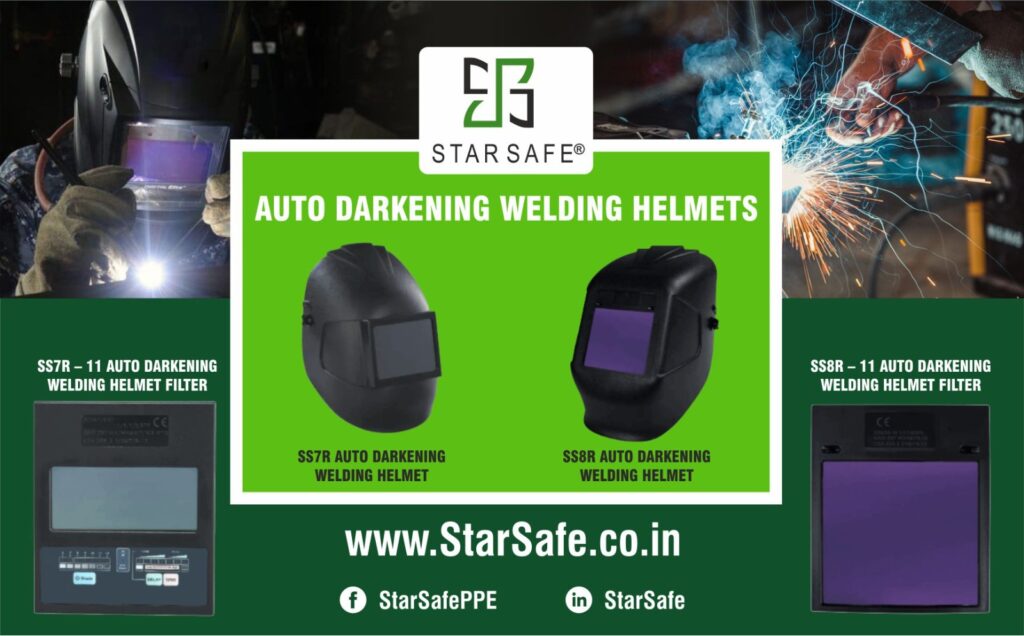As far as work places go, construction sites, coal mines, fabrication and manufacturing areas are some of those that require highly specialized PPE compulsorily to safeguard the work force from accidents and physical injury. Unskilled workers as well as skilled workers need to be protected from higher grades of risk than other workplaces. The selection of PPE must be suited to the nature of risk.
Welding is a high risk occupation for sure. And unlike in most other cases, there is a major direct risk to the eyes and face of welders. Be it welding sparks or the blinding glare, one cannot be too careful when metal is amalgamated to metal using incredible heat levels at close proximity to eyes. From heavy industries, chassis work, pipeline welding, shipbuilding to custom brackets, fabricated exhausts and tanks, to rust repairs and body mods, the welder is the only expert who can get the job done.
Managing operator safety and ease, in welding operations is a critical objective. Welding helmets are, therefore, a major safety tool. When the welding arc is not lit, the lens is too opaque for the wearer to see, so they must flip the faceplate up to position the welder and then back down to light the arc. This is necessary because the lens becomes too dark to see through if the welding arc is not lit. The development of auto darkening welding protection created a valuable aid for welders in that it made it possible to perform welding operations smoothly without having to constantly flip up the helmet to make adjustments. It also meant that the operator’s vision gained additional protection while doing these secondary tasks because of the base shading offered by auto darkening cartridges. The two most common lens options for welding helmets are auto-darkening and passive.
Choosing the right auto darkening helmet for any job requires understanding how optical clarity is rated and what level of sophistication you require from your helmet. When selecting a new welding helmet, you will see optical class ratings listed for helmets in the following manner: 1/1/1/1. The European Standards Commission developed this EN 379 rating for auto darkening welding cartridges to measure the quality of optical clarity in the helmet lens. For this rating system, auto darkening lenses get tested and rated in four categories. Each category is rated on a scale of 1 to 3, with 1 being the best and 3 the worst. While many weld helmets have optical ratings of 1/1/1/1, but it’s the rating combined with other factors like number of sensors, viewing area, and, on the most basic level, comfort that determine the best fit for a welder for a specific job.
With the specific auto darkening welding helmet needed for the job, it’s possible to get a clearer, more precise view of the weld bead. The creation of a rating system to help guide comparisons of helmet vision systems ensures that you are going to get the precision you want from your chosen helmet. Even when the lens isn’t darkened, it blocks harmful ultraviolet and infrared radiation. Infrared and ultraviolet light are the most harmful to the eyes, so this is crucial. Nonetheless, ease of use may be impacted by how long it takes for the lens to darken. A quality helmet will have already darkened in the split second it takes for your eyes to adjust to the arc’s brightness.
The speed at which an auto darkening helmet changes is usually quite swift – between 0.1 and 0.09 millisecond. But the number of sensors around the helmet will affect when and how the auto darkening is triggered. Typically, less expensive helmets will have one or two sensors, whereas more advanced helmets will have as many as five sensors. Obviously, the more sensors a helmet has, the more precise the auto darkening function will be. A helmet with a reaction speed rating of 1/20,000 a second or higher will reduce eye strain even when working for longer periods.
Technology is advancing rapidly, so now, some welding helmets are also equipped with Bluetooth that connects them to the power source. The helmet uses the arc-on signal from the torch trigger to darken the helmet rather than depending on the visible light setting off the sensors. When the arc shuts off, the lens lightens again.

